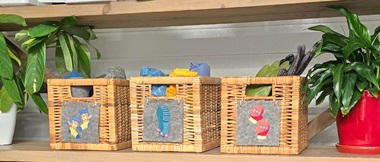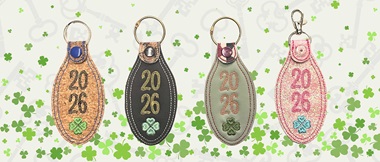
How to embroider on Towels
Embroidered towels make great personalised gifts and are so simple to make. Here are some tips to help create one-off bespoke pieces.
You will need:
Good quality, medium thick towels are the best to use, and will reward you with beautiful results. Very thin or stretchy towels can be embroidered, but the finished result will not look as good. The basic requirements are:
- Embroidery hoop: use one a size bigger than normal for your design
- Water-soluble film stabiliser
- Self-adhesive tearaway stabiliser (sticky back)
- Masking or sellotape with good grip
- Embroidery thread

Stabilisers
There are two aspects to consider here:
1. Stabilising to prevent your embroidery from buckling
A thick towel does not need stabilising. The fabric will be strong enough to hold together when embroidered.
Depending on the thickness of your towel, you may not be able to hoop it properly. If this is the case, use stabiliser bigger than the area of the towel you wish the embroider AND bigger than the hoop. Use the stabiliser overhang to properly hoop your towel. This is called ‘floating’ (for more on floating and a how-to, keep reading the article!)
If your towel is thin, you should consider using water-soluble or tearaway stabiliser. Water-soluble stabiliser is better if you’re stitching out an intricate design, as it will be hard to remove all the small pieces of tearaway.

2. Stabilising to prevent your stitches from sinking into the pile of the towel
Water-soluble film laid over the top of the towel prevents your stitches from sinking into the pile and gives you embroidery that sits beautifully.
When you are done embroidering, you simply tear the backing away. You can pick the bits out of intricate parts of the design with tweezers.
When you wash the towel, all of that will come out and leave a beautifully soft embroidered area.

Design Choice
Nobody likes a hard towel, so keep it simple! For towelling it is better to choose designs that do not have dense stitching or large, filled areas. Satin stitch fillings are better than tatami to prevent ultra-hard embroidery.Designs with knockdown stitches work best for towels. Knockdown stitches are a web of straight stitches that lay a foundation for the final stitches. The end result produces smooth stitches and edges.
It is always a good idea to test sew a design before using it on your final item/s.
Hooping
If you have good, thick towels, hooping may be difficult. If you force thick material into a hoop you can also damage your fabric with ‘hoop burn’. This is when the hoop leaves a mark on the towel because the pile has been flattened.A solution to both these challenges is to float the towel, rather than hooping it. Here is how to float a towel without getting your stabiliser stuck in the stitching.
- Hoop sticky back tearaway with the paper side up and stabiliser facing down.
- Tighten the screw of your embroidery hoop.
- Place the positioning grid in the hoop.
- Mark the centre, North, South, East and West. Connect N – S and E-W.
- Check the size of the embroidery. Add 1 cm all around.
- Mark this size out, centred in the hoop.
- Cut the window out with a blade.
- Score the stabiliser with a pin as close as you can to the hoop.
- Peel the paper backing away to reveal the sticky stabiliser.
- On the towel, decide where the centre of the design should be placed and make a small mark with a water-soluble pen. Draw North-South and East-West lines (find these by folding on the vertical through the centre and then on the horizontal through the centre mark). Use the positioning grid to mark lines on the wrong side of the towel.
- Fold the towel with right sides facing and fold on the N-S line. Bring to the hoop and match up the N-S lines and E-W lines on the towel and the stabiliser.
- Fold towel open and pat down.
- Cover the embroidery area with water-soluble film and secure with pins or tape. You are ready to load your towelling into your hoop and embroider!
- Embroider the design.
- Take the hoop out of the machine. Peel the film away and pick out the leftover backing from the small parts of the design.
- Peel the towel from the hoop and sticky back.
If your towels need stabiliser on the embroidered parts, follow these steps but do not cut the window.
If your design is intricate, using non-woven water-soluble stabiliser (the one that looks like interfacing), will be a better choice than tearaway.
Secure with adhesive spray and pins. When stitching take care to check your embroidery area and make sure there are no pins in the way. Follow with the film of your choice and embroider.
The downside of this method is that you will have to wash the towels to get rid of the non-woven water-soluble stabiliser.
Have fun trying different techniques. Each towel is different, but with a bit of practice you’ll soon have a feel for when a stabiliser is needed or not.
A good way to get the hang of things is to buy a pile of face cloths to experiment on. If they turn out well, you have items to add to your gifts drawer! If they’re not so great, don’t worry, you can use them for cleaning!




